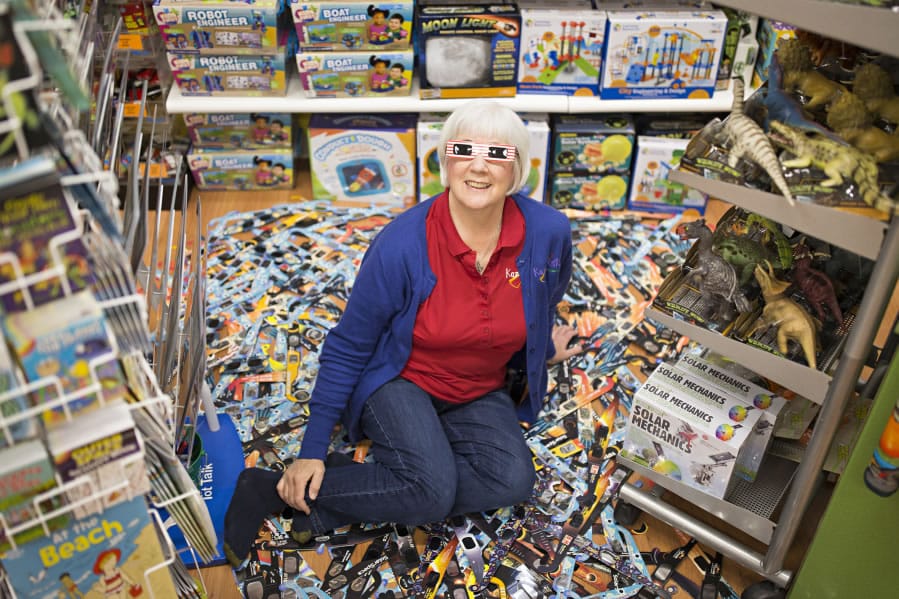The number of protective glasses that were worn during the Great American Eclipse on Aug. 21 must be astronomical.
Now, three Vancouver collection centers will help get those glasses to children who can use them in 2019, when solar eclipse paths cross Asia and South America.
The drop-off locations for those worn-just-once glasses are at Fort Vancouver National Historic Site, Clark County Public Health and Kazoodles toy store.
Fort Vancouver’s collection point is in the Visitor Center, near the east end of Officers Row, which also was a popular distribution point heading into the eclipse.
Re-clipse Those Glasses
Donate them:
• Fort Vancouver Visitor Center, 1501 E. Evergreen Blvd.
• Clark County Public Health, 1601 E. Fourth Plain Blvd., Building 17, information desk.
• Kazoodles toy store, 13503 S.E. Mill Plain Blvd., B-3.
•Mail: AWB Eclipse Glasses Donation, Explore Scientific, 1010 S. 48th St., Springdale, Ark., 72762.
Use them again:
•Oct. 14, 2023: Partial solar eclipse from Southern Oregon to Texas (86 percent coverage of the sun here).
•April 8, 2024: Total solar eclipse from Texas to Maine (22 percent coverage of the sun here).
On Aug. 21, when many viewers came to the historic site to witness the event, “Fort Vancouver distributed approximately 700 eclipse glasses free of charge,” said Theresa Langford, National Park Service curator. “Prior to that day, the Friends of Fort Vancouver sold approximately 800 glasses.”
Kazoodles has already collected 400 pairs of eclipse glasses.
“Some were never used,” said Mary Sisson, co-owner of the east Vancouver toy store. Some customers that bought big batches — maybe for a company’s employees or a nursing home’s residents — wound up with more than they needed.
The eclipse glasses are being collected by Astronomers Without Borders. The group will send the glasses to schools and other institutions in countries where they’re not available.
“We have an estimated 350,000 to 400,000 in now,” said Mike Simmons, president of Astronomers Without Borders.
“Now I’m expecting between 1 million and 2 million,” Simmons said. “Certainly more than 100 million were given away or sold. We may get back 1 percent of that, but it’s still a big number.”
100 times as many?
That’s a huge boost over previous efforts, thanks to a change in tactics.
“We’ve done this before, sending eclipse glasses to countries across Africa and South America,” Simmons said by phone from his office in Calabasas, Calif.
Those earlier efforts relied on crowd-funding. A really good response would generate enough money to buy and ship 15,000 glasses.
This time, “I was hoping for 50,000 without all the effort of crowd-funding.”
The next two solar eclipses across populated areas are in 2019: a total solar eclipse in southern South America and an annular eclipse (where the moon doesn’t quite cover the sun) in southeastern Asia.
People also can mail their eclipse glasses to the organization’s partner in the project, Explore Scientific.
While it’s more efficient to get the glasses in big batches from collection points, “People are welcome to (mail) them in, if there is no other way,” said Simmons, a self-described eclipse chaser who saw the recent total eclipse — his eighth — in Wyoming. His first was in 1979, near Goldendale.
There is another option: keeping them — and not just as souvenirs. They can be used to view sunspot activity until the area’s next solar eclipse. That will be in six years, said Jim Todd, director of space science education at Oregon Museum of Science and Industry.
Solar eclipse in 2023
The event on Oct. 14, 2023, will be an annular (or ring) eclipse. Its path across the U.S. will go from southern Oregon to Texas.
In the Portland-Vancouver area, “There will be a substantial shadow, well into the 80s,” in terms of percentage of totality.
There will be a total solar eclipse on April 8, 2024, from Texas to Maine. It will be a partial eclipse here, covering 22 percent of the solar disc.
If they want to reuse their protective glasses, people should make sure the lenses don’t have scratches or holes. As far as shelf life goes, people who got solar glasses from reputable distributors last month shouldn’t be concerned. Even though some sources recommend discarding eclipse glasses after one, two or three years, “the filter material is required to not degrade,” according to the Astronomers Without Borders website. “The paper (frames) can be damaged by inappropriate storage, which may be the concern some manufacturers have.”
A prominent element of the website is the group’s motto: “One people, one sky.”
“Astronomy is in every culture, and has been through history,” Simmons said. “We share the same sky with each other in ways that have nothing to do with borders.”




